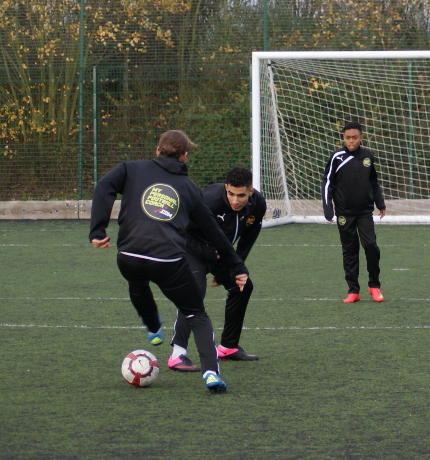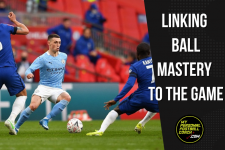Adults play a very important role in child development at all levels. Educational theory and particularly the work of Bandura and Vygotsky outline the importance of adult involvement in the social environment in supporting children’s learning.
Vygotsky’s Zone of Proximal Development
Vygotsky’s Zone of Proximal Development (ZPD) is an ideal model to use when judging when guidance from adults can be most effective. Rudolph Schaffer who was a renowned developmental child psychologist describes the ZPD as:
“The boundaries of the ZPD are determined by the gap between what children can do on their own and what they can achieve when acting as the junior partner of a more knowledgeable person”. (Schaffer: 1996).
Football skills and 1v1 domination is a complex area with many different variables in play. This is where I call upon scaffolding theory which is synonymous with ZPD and fundamentally important to me and my role as a skills coach.
Scaffolding Theory
“[Scaffolding] refers to the steps taken to reduce the degrees of freedom in carrying out some task so that the child can concentrate on the difficult skill she or he is in the process of acquiring” (Bruner, 1978, p. 19). See more here or on the video below
But why should we teach them at all, why not let them develop or not develop naturally? Because, if you look at top flight football, I believe there are around 6-8 1v1 soccer skills used regularly in the top flight leagues around the world. There are many more, but i argue 6-8 main ones used successfully. These 1v1 soccer skills create problems for defences and change games.
Kidman and Lombardo (2003) argue that an athlete centred approach to coaching is important when developing decision makers. More traditional approaches or coach centred coaching often focus on limited forms of learning that emphasise memorising and mimicking rather than understanding or solving problems. The danger here is of players becoming robotic in their thinking and actions. This removes autonomy from the player and means they are more reliant on the coach.
Kidman and Lombardo also argue that when coaching tactics or skill, coach-centred coaches tend to give participants specific directions on what exact moves to perform. That say that athletes should be given the opportunity to practice skill and techniques within the context of the game rather than separate from it. When athletes are given freedom to explore soccer skills within a game situation without the coach telling them what to do, they become more productive in terms of learning in context and importantly their decision making skills improve. This has implications for the researcher as the project will look to measure the increase of skills used within game situations.
This is why the game should always be the rule rather than the exception, we want players to be able to act autonomously and carry out decisions. There is however no point in a player being able to carry out a decisions when they don’t have the technique to do so. We are also striving to develop players who can change games.
What changes games?
Normally this is a forward pass or a successful 1v1 moment. This is where we sometimes have to push or challenge players as often in game situations, players will avoid a 1v1 looking for an easy pass instead. This is where 1v1 isolated practices are so beneficial as players are forced to solve the problem against a defender. Try going 1v1 with a player towards a line or goal and see how many decisions you have to make. This is also an opportunity for the coach to gauge the 1v1 ability of a player and see if additional support is needed. The young player may need to come out of ‘the game’ environment temporarily to work on or develop some skills. You then measure the learning by putting them back in live ‘1v1’. This may and most likely will be a lengthy process.
The best world cup goal ever?
How many successful 1v1 movements can you see Maradona make and boy did he change the game?
The paper by Williams et al 2003 highlights schema theory by suggesting that players new to a particular skill have not yet gained the necessary representations of the skill in their memory so they are more likely to process information consciously through various sensory loops. As a player becomes more skilful there is a switch in attending to sensory information to becoming more automatic. This automatic stage will see the participant perform the skill more consistently due to the improved motor programmes which allow sensory information to be processed at a subconscious level.

It is important to remember that when specifically dealing with young players (8-11) that they are at the beginning of their journey in terms of their footballing life and we want to give them opportunities to be successful. Shea et al (1990) argue that low contextual interference practice conditions may actually be beneficial in the beginning stages of skill acquisition.
‘When the learner is relatively inexperienced, random practice may over load the system and its potential benefits could be disrupted.’
When players are learning new skills or building their relationship with the ball, we must create conditions where players can achieve success. Whether it’s focusing on 1v1, or introducing new 1v1 techniques that the players can then take into game situations. As stated before, this is never imposing, but simply introducing. Showing players some tools that they can then choose to use if they wish.
The 8-11s phase is unique and different to the 12-16s age bracket in my opinion and breaking this up is important when thinking about skill acquisition in young footballers. We need more 8-11s specialists who understand the unique nature of this age group and the differences in provision to the 12+. We can’t bracket all players with the same development model. I must also stress that all of this is just a small part of the player development jigsaw and majority of team sessions should be structured as small sided games.
I know I have described a lot of science and education to support various mechanisms but one thing is paramount, as a soccer skills coach it’s not my job to tell the player what to do but more to facilitate the learning. I need to support the player in constructing their own knowledge. The psychologist Bruner calls this process Discovery Learning, I give the players as much information as they need without trying to organise it for them. The spiral curriculum can add the process of discovery learning
This is also where scaffolding theory comes in, do the players need additional support in this area? Or are they able to solve the problems themselves. For me this issue is more acute in the Academy environment as we are trying to support players into elite football, where at the age of 16-18 they need to have the tools to be effective in games. Gifted and talented children in any field have to be challenged, and it is our job as educators to do this. We should use guided discovery where ever possible to support the players in coming to their own conclusions, but sometimes we have to take a more direct role than this. Yes I want chaos in my sessions but I also demand that players leave the foundation phase with the ability to use both feet and dominate 1v1. This is where i can and will, if necessary, come in to support.
Saul Isaksson-Hurst
Head Coach at MyPersonalFootballCoach.com
Part 3: Putting it into practice
Read Part 3 here





